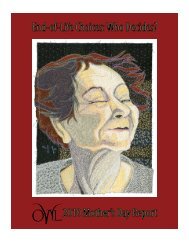elder abuse: a women's issue - OWL-National Older Women's League
elder abuse: a women's issue - OWL-National Older Women's League
elder abuse: a women's issue - OWL-National Older Women's League
Create successful ePaper yourself
Turn your PDF publications into a flip-book with our unique Google optimized e-Paper software.
Institutional Elder AbuseAs a requirement under the <strong>Older</strong> AmericansAct, states have developed Long Term Care (LTC)Ombudsman Programs to try and sort through and dealwith incidents of <strong>abuse</strong>. 29 Ombudsmen are advocatesfor the residents of nursing facilities, care homes andassisted living communities and are generally trainedto resolve disputes. The Ombudsman Programs arealso situated to address complaints and advocate forimprovements within the long-term care system in theirstate. In 2007 there were close to 14,000 institutionalcomplaints of <strong>abuse</strong>, gross neglect and exploitation thatwere investigated by the Ombudsman offices. 30 Many ofthe problems include delays in reporting, under-trainedstaff, and lack of oversight by the Medicaid and Medicare“ Long-term care ombudsmen workon a daily basis to prevent <strong>abuse</strong>,neglect, and exploitation as well asto assist residents who are victimsdue to systems failures and violence.Each year, they help thousands ofresidents who have been victimizedget the help and support they need. ”- Lori Smetanka, Director, <strong>National</strong>LTC Ombudsman Resource Centerprograms. 31 Many of the state Ombudsmen Programsare staffed by volunteers, making it difficult to haveenough people investigating allegations. Many times,the volunteer ombudsman is the only person visiting oradvocating on behalf of a nursing home resident.The NCEA states that the main reasons forinstitutional <strong>abuse</strong> include stressful working conditions,staff shortages, staff burnout and inadequate stafftraining. 32 The turnover is so high, that facilitiesoftentimes have difficulty keeping up with backgroundchecks and are unable to verify caregiver qualifications.In a 2000 study, evaluations showed that when caregiverswere educated on the <strong>issue</strong>s of <strong>elder</strong> <strong>abuse</strong>, Alzheimer’sdisease, how to access resources, and the caregiver’s ownrisk of <strong>abuse</strong> by residents, that there was a change inattitude, behavior and knowledge by the participatingstaff. 33 Education and training programs for caregiversare seen as one of the best ways to prevent <strong>elder</strong> <strong>abuse</strong>.It is also imperative that public education campaignsinvolving media, literature and various advocacyresources are directed at seniors themselves. 34Prosecution of an AbuserProsecution in <strong>elder</strong> <strong>abuse</strong> cases is exceedinglydifficult. The victim often fears perpetrator retaliation,especially if the <strong>abuse</strong>r is a family member. Oftentimesthe victim is incapacitated or suffering from dementiaor Alzheimer’s disease and is unable to be a witness inthe case. The “Rules of Evidence” state that hearsay isinadmissible. Hearsay is an out of court statement thatone party wants to use in the court proceeding. In manystates, there are hearsay exceptions used in child <strong>abuse</strong>cases and cases concerning mentally ill adults. This typeof exception should be extended to the victims of <strong>elder</strong><strong>abuse</strong> to assist the prosecution in meeting their burdenof proof. In special circumstances the exception shouldallow for testimony to be videotaped or for the victim toappear via closed circuit television as is done in certainchild <strong>abuse</strong> cases. 35Addressing the ProblemTo adequately address the problem of <strong>elder</strong> <strong>abuse</strong>,there are many steps that must be taken. There mustfirst be increased public awareness, improvements inand development of comprehensive state and federallegislation, cooperation between law enforcementand health care providers, education and trainingon preventing and detecting <strong>abuse</strong>, enforcement ofmandatory reporting regulations, support for caregivers,and improvement in hiring practices. 36 On the federallevel, Congress began to address the problem by creatingand funding a new chapter to the <strong>Older</strong> Americans Actcalled Section VII, Vulnerable Elder Rights. Section VIIhas been used primarily for education and to promotethe collaboration of different agencies and also defines<strong>elder</strong> <strong>abuse</strong>, allowing for federal money to be providedto the NCEA for training and awareness. However, thissection has been flat-funded or underfunded for thepast several years and is largely lacking the adequatetools necessary to address the real needs of older adults.Relative to the Violence Against Women Act and10



